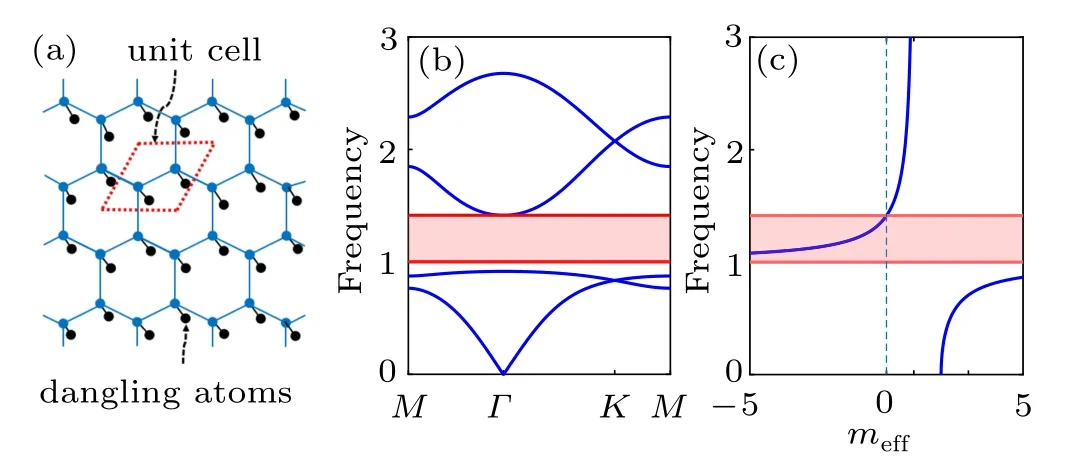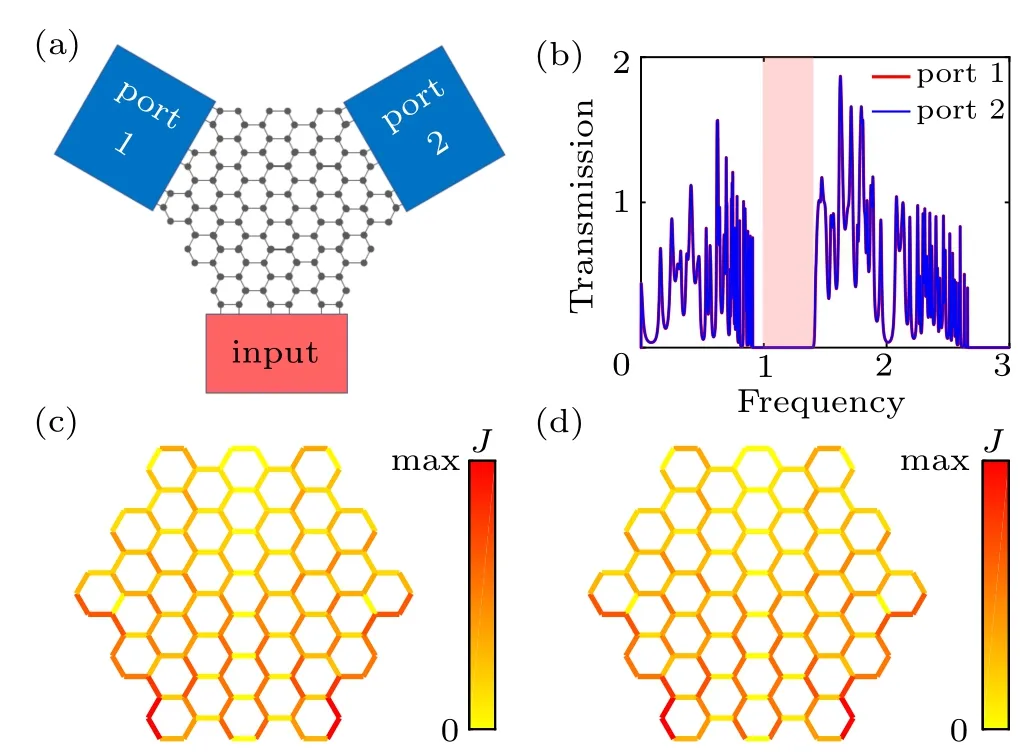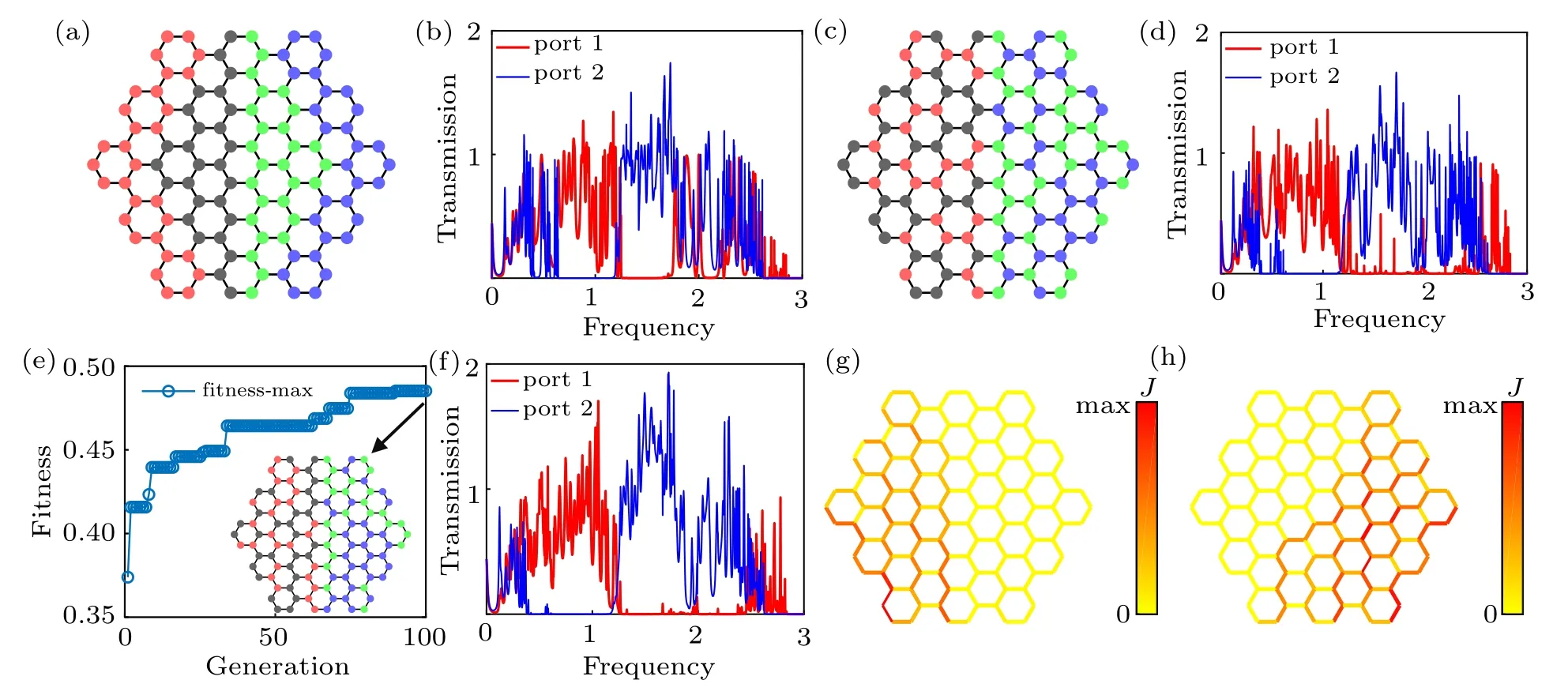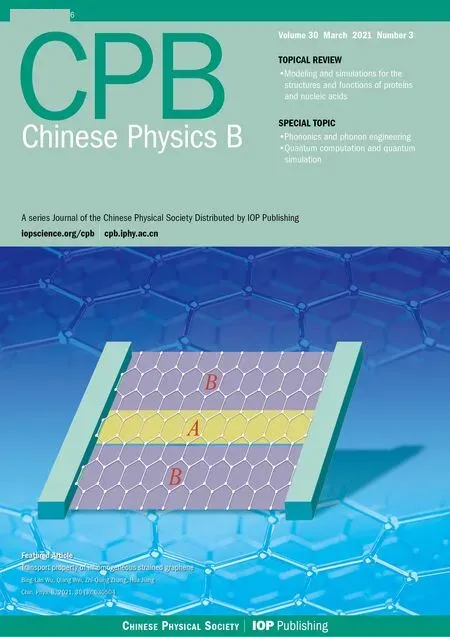Designing thermal demultiplexer: Splitting phonons by negative mass and genetic algorithm optimization∗
Yu-Tao Tan(谭宇涛), Lu-Qin Wang(王鲁钦),†, Zi Wang(王子), Jiebin Peng(彭洁彬), and Jie Ren(任捷),2,‡
1Center for Phononics and Thermal Energy Science,China-EU Joint Laboratory on Nanophononics,Shanghai Key Laboratory of Special Artificial Microstructure Materials and Technology,School of Physics Science and Engineering,Tongji University,Shanghai 200092,China
2Shanghai Research Institute for Intelligent Autonomous Systems,Tongji University,Shanghai 200092,China
Keywords: phonon transport,thermal demultiplexer,optimization algorithm
1. Introduction
Manipulating heat transport and understanding the mechanism are long-standing goals in both classical and quantum open systems.[1]Conventionally, many studies have presented phonon transport manipulation in different systems such as aperiodic lattice,[2,3]composite material,[4]porous system,[5]graphene folding[6,7]isotopic doping,[8,9]disorder system,[10,11]edge roughness,[12]and so on. Furthermore,in analogy to the modern electronics, many thermal functional devices have been realized theoretically, including the thermal diode,[13,14]the thermal transistor,[15,16]the thermal memory,[17,18]the thermal capacitor,[20]and even the thermal logical gate for computing.[19]Moreover, many experiments have realized these thermal operations.[21-23]
In phononic thermal transport, people usually integrate the whole phonon frequency range when calculating heat flux and thermal conductivity, because all spectra contribute to thermal transport. Yet, there is lack of exploration of controlling the spectrum-resolved phonon transport at the different frequencies and wavelengths. Managing different phonon transport of different frequencies can largely broaden the scope of applications of phononic devices, which is able to achieve the spectrum-resolved manipulations of thermal and phonon transport, as the multiplexer and demultiplexer in phononics. For example, dielectric wavelength (frequency)demultiplexer has been demonstrated in integrated photonic devices.[24,25]This frequency-dependent demultiplexer will split the light, which means the short wavelength (high frequency) light will transmit to one port while the long wavelength (low frequency) light will transmit to the other. Similarly, there exist both theoretical and experimental proposals for acoustic demultiplexer by exploiting sonic crystals.[26-28]
In this work,we design a thermal demultiplexer that will split phonons of different frequency ranges and transmit them to different ports. Concretely, in Section 2 we first introduce the dangling atoms model, which is shown in Fig.1(a).Dangling atoms will lead to zero transmission in specific frequency range,which can be explained by the concept of negative mass.[29-33]Then we show how to calculate the transmission and heat flux via the nonequilibrium Green’s function(NEGF) method.[34-37]In Section 3, we start with a thermal demultiplexer with two-mass dangling atoms that can split the phonons into different ports with different frequency ranges.We then use genetic algorithm(GA)to optimize the structure for a better demultiplexer performance. Finally, we conclude in Section 4.
2. Structure and method
The primary structure we used in this paper is the infinite honeycomb lattice. But each atom connects to an extra atom,namely,the dangling atom,whose schematic view is shown in Fig.1(a).

Fig.1.(a)Schematic view of infinite honeycomb lattice with dangling atoms and the unit cell is shown in red dashed parallelogram. (b)Dispersion relation of infinite honeycomb lattice with dangling atoms. (c) Effective mass versus frequency. The pink shadow region denotes the effective negative mass zone. The frequency gap of the dispersion relation almost coincides with the effective negative mass zone.
To understand how the dangling atoms affect phonon transport, we calculate the dispersion relation of the honeycomb lattice with dangling atoms shown in Fig.1(b). In our calculation, we set lattice atoms’ mass m0=1, dangling atoms’ mass md=1, the coupling constant kd=1 between them,and the inner coupling constant of lattice atoms k0=1.Here without loss of generality, we consider scalar phonon model, i.e., only one-dimensional vibration, the scalar displacement from each atom’s equilibrium position,is taken into account. After Fourier transformation,the equation of motion is described as

The dynamical matrix K is described as

To describe the collective behavior of lattice atoms and dangling atoms,we introduce the effective mass term. For the effective mass meff,it can be calculated by

Here meffis a function of frequency ω.[32,33]
In phononic metamaterial,effective negative parameters,which means some effective parameters will become negative at some frequency range,have been thoroughly studied.[29-31]The mass-spring structure[32]is a common used system to realize effective negative parameters. Interestingly, effective negative parameters may contribute to zero transmission.[33]In our system, the effective negative mass (ENM) frequency range is given by

In Fig.1(c), we not only show the effective mass curve but also mark the ENM zone by the pink shadow zone. In the frequency range of ENM,original propagating modes will become localized or resonant modes which contribute to the frequency gap that phonon cannot transport. As we expect,the ENM region matches with the band gap very well.
From the dispersion relation, we can see that the upper boundary frequency of ENM and band gap are equal while there is tiny difference between two lower boundaries. This is mainly because the effective mass works well in long wave limit Γ point but poorly on the border of Brillouin zone M point due to Bragg scattering. The two upper boundaries match well because the minimum value of optical branches(two upper branches)are at Γ point.However,it seems that the maximum values of acoustic branches (two lower branches)are also at Γ point,mainly because of the band fold. The maximum value of acoustic branch was originally on the border of the Brillouin zone but after the band folding it turns to the Γ point.
We propose a three-port demultiplexer whose diagram is shown in Fig.2(a). The structure is a finite honeycomb lattice with dangling atoms and connects with three ports which are Langevin heat baths. We then use NEGF method to calculate transmission and heat flux.[34,37]First of all, we set the displacement vector and momentum vector as X ={x1,x2,...,xN}Tand P ={p1,p2,...,pN}T, then the Hamiltonian of this system can be expressed as

where M is the mass matrix and K is the coupling matrix.Then the retarded Green’s function Gr(ω)for a common twoport setup is given out






Fig.2. (a)Diagram of thermal demultiplexer. The main body is constructed of finite honeycomb lattice with dangling atoms,but not draw up for convenience.One input port(red rectangle)and two output ports(blue rectangles)connect with the edge atoms. (b)Transmissions of ports 1 and 2 calculated by NEGF.They are identical due to the symmetry of the junction.The ENM zone is marked by pink shadow region. (c)Heat flux in low frequency range and the integral interval is[0, 1.25]. (d)Heat flux in high frequency range and the integral interval is[1.25,5].

3. Results and discussion
In this section, we first study the two-mass thermal demultiplexer. To achieve a better performance,we use the fourmass thermal demultiplexer and genetic algorithm to optimize the configuration.
3.1. Two-mass configuration
Based on the above analysis, it is easy to tune the band gap by changing the dangling atoms’ mass. Hence we can use this effect to realize a phonon demultiplexer. One of the designing methods is optimizing the distribution of dangling atoms with different mass to form several freqeuncy gaps,which can influence the phonon transport.
As for the configuration of dangling atoms,we first consider the equipartition configuration, which means each kind of dangling atoms only exists on one side. It is intuitive that phonons in different frequency ranges may split roughly and flow into different ports. The configuration of dangling atoms is shown in Fig.3(a). The lattice atoms (m0=1) with dangling atom mass m1=0.5 are on the left part,marked by red and those with dangling atom mass m2=2 are on the right part,marked by blue.

Fig.3. (a)Schematic view of sites configuration with equipartition of dangling atoms.The sites with dangling atom mass 0.5 are colored as red,while the sites with dangling atom mass 2 are colored as blue. (b) Transmission of equipartition configuration which shows that different mass of dangling atoms will contribute different frequency gap.(c)Heat flux in low frequency range [0.66, 1.25]. In this frequency range, the heat flux will mainly flow into port 1. (d) Heat flux in high frequency range [1.25, 1.70]. In this frequency range, the heat flux will mainly flow into port 2. In these two frequency ranges,the heat flux and phonons have been split completely,while in the other frequency range the heat flux does not split completely.
The transmission is shown in Fig.3(b),which can be calculated by NEGF method. It illustrates that transmission of port 1 in frequency range [0.66, 1.25] is much larger than the transmission of port 2. While in another frequency range[1.25,1.70],the result reverses. This result demonstrates that in equipartition configuration the transmission of one port will be largely affected by dangling atoms of its side. We also plot the heat flux calculated by Eq. (10) in Figs. 3(c) and 3(d).Figure 3(c) shows the heat flux in low frequency range and the integral interval is[0.66, 1.25]; while Fig.3(d)shows the heat flux in high frequency range and the integral interval is[1.25,1.70]. The reason we choose these two intervals is that phonons in these two frequency ranges split quite completely.To show the degree of splitting,we define α as

where Jmaxand Jminare the maximum and minimum values of the two ports’heat flux in the same frequency range. After defining the rate α,it is easy to calculate that αl=37.3 in low frequency range[0.66,1.25]and αh=253.2 in high frequency range[1.25,1.70].
3.2. Four-mass configuration and genetic algorithm optimization
Although equipartition configuration of two masses can split phonons in certain frequency range, it is still possible to broaden the splitting frequency range and enhance its performance. To reach this goal, we introduce four kinds of dangling atoms. We choose four different dangling atom masses: m1=0.5(red),m2=2(blue),m3=0.2(black),and m4=5(green). We first calculate the transmission of equipartition configuration shown in Fig.4(a). From the transmission Fig.4(b), we find that the splitting effect does not get better.Then we choose a random configuration shown in Fig.4(c)and calculate the transmission shown in Fig.4(d). Compared with transmission of equipartition configuration, the splitting frequency range broadens. Then we attempt to find the best configuration. Thus,we perform the GA to optimize the configuration.

Fig.4. (a) Schematic view of equipartition configuration of dangling atoms and their masses are 0.2 (black), 0.5 (red), 2 (blue), and 5 (green),respectively. (b) Transmission of equipartition configuration. (c) Diagram of random configuration which is one of the initial configurations of GA optimization. (d)Transmission of random configuration which broadens the splitting frequency range. (e)Optimization curve and the inset is the final optimal configuration. (f)Transmission of the final optimal configuration. (g)Real space profile of heat flux in low frequency range[0.40,1.25]. (h)Real space profile of heat flux in high frequency range[1.25,2.45]. The splitting frequency ranges are expanded larger and clearer. The heat flux in the lower frequency range will almost completely flow into the left port,while the heat flux in the higher frequency range will almost completely flow into the right port.
Machine learning has attracted lots of interest due to its efficiency of dealing with complex problem in the area of photonics,[38]phononics,[39]etc. GA is the one that can solve the problem of finding extreme value.[40,41]
The explicit process of GA is described as follows:(1)define the fitness to represent how close the result is to the optimization objective, (2) initialize the population containing dozens of genotypes (various configurations in this paper),(3) calculate fitness, (4) choose a few of the highest fitness configurations to create a new population by crossover and mutation, (5) repeat (2)-(4) for generations. An appropriate fitness function is essential to GA. Our objective is to split the phonons with different frequencies,thus it is necessary to enlarge the transmission difference of two ports in a certain frequency region. Therefore we define fitness function F as

where T1and T2are the transmissions from the input port to port 1 and port 2,respectively. ωcis the critical frequency that we want to split the phonons and we set ωc=1.25 here. The number of population is 30 and optimization will evolve for 100 generations.
We plot the maximum fitness of every generation as the optimization curve shown in Fig.4(e)and the inset is the optimal configuration. The transmission is calculated and shown in Fig.4(f). It is obvious that the optimal configuration works well in broader frequency range [0.40, 2.45]. Then we calculate the heat flux of two frequency ranges [0.40, 1.25] and[1.25, 2.45] shown in Figs. 4(g) and 4(h), respectively. And the splitting rate αl=51.7 and αh=125.6, which implies a good splitting effect.
Finally,we give a qualitative explanation of the optimization result. We have the knowledge that the certain mass of dangling atoms will cause the certain frequency gap so that we need different masses of dangling atoms to broaden the frequency gap. Besides,compared with the equipartition configuration,disorder in random and optimal configurations will merge the frequency gaps induced by different masses of dangling atoms. For these two reasons,the optimal configuration has much better performance. Furthermore, as for an atom whose m ~10−26-10−27kg and a ~1 ˚A,it yields the unit of physical frequency(k/m)1/2~1013Hz.
There is still a key problem remaining to be solved in our work that the thermal demultiplexer cannot work in a low frequency range. This is mainly because vibration of low frequency cannot be influenced by localized mode no matter which mass we choose. And even for the heterogeneous onsite potential, it will suppress the phonon transmission in the low frequency range but will not solve the problem completely since the transmission in low frequency range will shift to higher frequency range,which makes it still difficult to distinguish the transmissions of two ports. Another thing that can be improved is the splitting rate α since we find the α of low frequency range is quite smaller than the high frequency one.We are going to reveal it in future work.
4. Conclusion
In summary,we have proposed the thermal demultiplexer,which selectively transmits phonons of different frequencies to different ports. This is achieved by exploiting the effective negative masses caused by dangling atoms to induce frequency gaps. By constructing a three-port device,we have calculated the phonon transmission and spectrum-resolved heat flux of a two-mass configuration, which shows phonons splitting in frequencies at different ports. To broaden the phonon splitting frequency range, we have further chosen four kinds of masses and used genetic algorithm to optimize the configuration of dangling atoms for a better performance. Our study finds a way to selectively split spectrum-resolved phonons to different ports,which would provide a new means to manipulate phonons and guide the design of phononic devices in the future.
- Chinese Physics B的其它文章
- Transport property of inhomogeneous strained graphene∗
- Beam steering characteristics in high-power quantum-cascade lasers emitting at ~4.6µm∗
- Multi-scale molecular dynamics simulations and applications on mechanosensitive proteins of integrins∗
- Enhanced spin-orbit torque efficiency in Pt100−xNix alloy based magnetic bilayer∗
- Soliton interactions and asymptotic state analysis in a discrete nonlocal nonlinear self-dual network equation of reverse-space type∗
- Discontinuous event-trigger scheme for global stabilization of state-dependent switching neural networks with communication delay∗

